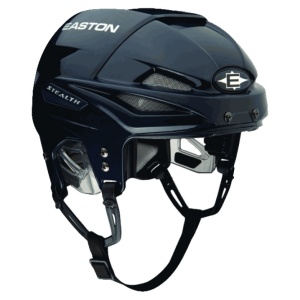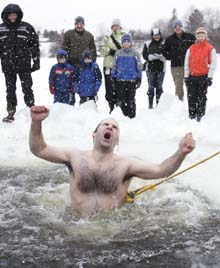I don’t know if you’ve been keeping up with the headlines, but there’s been a (potentially) major break-through in concussion science. Basically, U.S. scientists believe they have developed a way to detect CTE (chronic traumatic encephalopathy), in living athletes. CTE is a concussion-related brain disease, which can bring on depression, personality changes, and dementia. Up until this find, it was only detectable by autopsy.
Read more here.
It’s been found posthumously in the brains of a number of NHL and NFL players, including NFL linebacker Junior Seau, age 43, who committed suicide last May, and NHL enforcer Derek Boogaard, age 28, who died of an overdose in May 2011. Scientists say that this new discovery may aid in finding early interventions for those showing signs of the disease, and may lead to improved concussion management strategies.
Great news, right?
Well, yes. Provided the information about the potential long-term effects of concussions and their prevention is spread to the athletic community. Also, the athletic community needs to listen and heed the recommendations given.
That’s where the trouble starts. Because concussions are so prevalent in contact sports, we’ve relegated them to the status of minor injuries. If you’re tough, you shake it off, and get back at it.
A prime example, Pittsburgh Steelers safety, Troy Polamalu (yes, from the shampoo commercials), admits that he’s lied about the severity of his head injuries to get back on the field. Says Polamalu, “When you get your bell rung they consider that a concussion — I wouldn’t … If that is considered a concussion, I’d say any football player at least records 50 to 100 concussions a year.” Polamalu has no trouble with the idea of hiding an injury because, “there’s so much built up about team camaraderie and sacrifice, and football is such a tough man’s game … It’s that commitment you need to play football. You feel sore, you’re beat up, you’re injured, you’re legitimately injured, most people may take three months off to work in an office, we choose to play the next week.”
A recent study found that concussion denial culture is thriving in hockey at all levels. Researchers followed two Canadian university teams, both a men’s team and a women’s team, and scanned every player’s brain before and after the season. Players who sustained head injuries were scanned 3 times following the injuries. Even though the teams in questions had signed on for the study, the physician observer encountered serious resistance to their suggestions around non-play. Rather, coaches encouraged their athletes to “skate it off” and players who had sustained some kind of blow to the head were often quickly returned to play. Said the researcher, “The athlete’s and coach’s decision to return to play the next day despite incurring a minor concussion reflects what occurs thousands of times every day.”
Head injury is not the same as muscular injury. It is not understood in the same way, and the long-term effects haven’t been studied in the same way. To me, that doesn’t mean we should be less cautious when we injure our heads, but rather MORE cautious. Because diagnosis, symptoms, and severity vary, it’s important to listen to your body when you sustain a head-injury and commit to making a full recovery before returning to play.
Dr. Inga K. Koerte, a researcher in the above-mentioned study notes, “You may not need to have a diagnosed concussion to actually have changes in your white matter… It may be that subconcussive blows to your head accumulate over time, so that you develop changes that are similar to when you have one clinical concussion.” The long and the short – take head injuries seriously.
Education is starting to improve around head-injury, especially with mega-star Sidney Crosby having spent a good deal of his 2011-2012 season side-lined recovering from a concussion, but we need to make sure that we are implementing the education we receive on a team level.
Here’s where derby comes in. We are athletes, though not professional athletes. We do not have immediate access to the best that sports-medicine has to offer, so we need to rely on a set of best-practices. We are a new enough sport that we don’t need to fall into the trap of “skating it off”. We can dictate what kind of culture we want when it comes to injuries – do we want immediate return-to-play at the expense of the skater’s long-term career? Or do we want to be more progressive, making sure that we monitor, are honest about, and encourage adequate recovery time for each skater injury. Because of our newness, our skater-run roots, and the fact that we’re still defining who we are and what the sport is within the public eye, I think roller derby is perfectly suited to lead the charge when it comes to getting rid of concussion-denial.
Yes, we’re tough girls. Yes, that’s some of the appeal of derby. But ain’t nobody gettin’ paid, so nobody should be putting their long-term well-being on the line. We can be a competitive, hard-hitting sport that admits that concussions happen – and when they happen, we pay attention and we pull the player until recovery is complete, however long it takes. Concussions are an “invisible” injury, let’s not bully or badger people into quick return just because we can’t see the damage that’s been done.
Derby is ahead of the curve with our rules against back-blocking, hopefully curtailing some of the more serious impacts. WFTDA has some strongly worded safety protocols regarding concussions, which is great too. Where we need to be vigilant is in application. We can always be improving skater safety.
First of all, please, for the love of your brain, make sure that your helmet is certified, multi-impact, and that it fits snugly.
Don’t worry about what your helmet looks like, worry about how much it is protecting you. Replace it after any major impact. Also, invest in a good mouthguard.
Secondly, have a response team (risk-management, injury committee, whatever your league calls it) that is trained to recognize concussion-like symptoms – headache, head “pressure”, neck pain, nausea, vomiting, dizziness, blurred vision, amnesia, balance problems, sensitivity to light and/or noise, confusion, drowsiness, etc. Have copies of the SCAT2 (the first-aid gold-standard for head-injury evaluation) available to your team, and use them when injury occurs. Ensure that the injured person is monitored by someone for the next 24 – 48 hours. This is ideally a domestic partner, since you’ll want to monitor them through sleep, waking them every 2-3 hours, but if need be, assign a member of the team (or the skater’s derby wife) to the task.
Finally, take head injuries recovery seriously. Make sure that coaches and skaters have a shared policy when it comes to return-to-play. In this sport, you do not win a medal, or get a contract bump for getting back out there before you are ready. If you’re dizzy, sit. Listen to your body first, your coach second. That might be a contentious point, but only you know how you are really feeling. Go to your doctor, tell the truth about your symptoms and come back only when you are cleared. Find a head injury strategy that you, your team, and your coaches are comfortable with and stick to it no matter what.
From Derby Hurts, here’s an excellent concussion policy:
When a player shows ANY symptoms or signs of a concussion:
- The player will not be allowed to return to play in the current game or practice.
- The player will not be left alone; and regular monitoring for deterioration is essential over the initial few hours following injury.
- The player should be medically evaluated following the injury with the use of the SCAT2 evaluation form on the sideline to determine need for evaluation by MD.
- Return to play must follow a medically supervised stepwise process.
- A head injury warning sheet must be given to the athlete, parent/guardian, or friend of the athlete who is taking care of them.
A player should never return to play while symptomatic.
“WHEN IN DOUBT, SIT THEM OUT!”
If you’re looking for a refresher on what a concussion is, and how to treat it, please check out Papa Doc’s Derbylife article all about using your head.
For a quick link to the SCAT2 and pocket card, go here. WFTDA’s safety protocols also have a copy.
And, if you want to learn more, here’s some additional concussion and sports culture reading:









